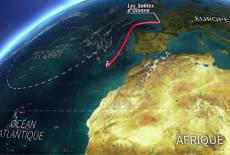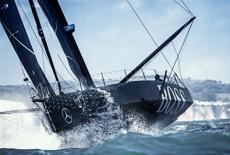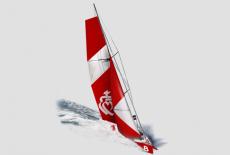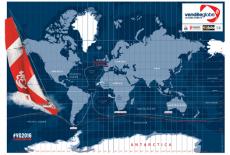Vendee Globe Solo Round The World Race Starts

06.11.2016
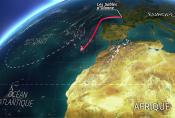
Vende Globe - Singlehanded Round The World Race
The legendary Vendée Globe singlehanded round the world race set sail from les Sables d’Olonne, France on Sunday 6 November 2016.
The Vendée Globe is the only non-stop solo round the world race without assistance. The event was created in the spirit of the Golden Globe, which in 1968 was the first non-stop solo round the world race via the three capes - Good Hope, Leeuwin and the Horn.
Out of the 9 pioneers who set sail in 1968 only one made it back to Falmouth UK. On 6 April 1969, after 313 days at sea, the British sailor Sir Robin Knox-Johnston became the first sailor to sail alone around the world without stopping.
Twenty years later, the French sailor Philippe Jeantot came up with the idea of a new solo round the world non-stop race. The Globe Challenge was born which became the Vendée Globe. On 26 November 1989 13 sailors set off on this first edition, but only 7 made it back to les Sables d’Olonne. Since then there have been seven editions of what is often referred to as ‘The Everest of the seas’.
The current record is held by Frenchman François Gabart who won the 2012 - 2013 Vendee Globe with a time of 78 days. The 2016 - 207 race has 29 skippers entered.
Over seven previous events 138 sailors have lined up at the start of the Vendée Globe, but only 71 have managed to cross the finishing line which shows the huge difficulty of this global challenge. Sailors push their boats hard for 24 hours a day while facing extreme conditions, including ice and mountainous waves in the Southern Ocean.
On day one the wind angle and speed plus the sea state appeared to be favouring the foilers. In the first few hours of the race, the fleet remained relatively close together with the first fifteen boats within five miles of the leader. By day two fhe fleet was split into three distinct groups spread over 120 miles and Britain’s Alex Thomson had taken the lead sailing the foil assisted 'Hugo Boss'.
The Boats
The Vendée Globe boats all measure 18.28 metres (60 feet) with a draught of 4.50 metres (14.75 feet). Carrying a lot of sail, they are the most powerful monohulls in the world skippered by a solo sailor. They can exceed thirty knots downwind.
The class rules are determined by the IMOCA class (International Monohull Open Class Association), founded in 1991 and recognised by the ISAF (International Sailing Federation). The rules were recently updated. They now impose a standardised keel, the choice between two masts, a traditional one or a wing mast, with the number of appendages and ballast tanks limited. The rest is down to the designers.
Foils Allowed For 2016 – 2017 Race
The big news this year is that the 2016 - 2017 Vendée Globe rules allow the latest generation of boat to be equipped with foils. These appendages lift the hull of the boat up which reduces the drag and enhances performance.
This will be the first round the world race for these new machines. But the boats from the previous generation have been fine-tuned and developed and are more reliable for the moment, meaning they are in with a good chance too. In fact the older boats that have won all the major races since the last edition of Vendée Globe.
Vendee Globe Home >
View the Vendee Globe Tracker and Rankings >
The Course
Sailors go around the world from west to east via the three major capes of Good Hope, Leeuwin and the Horn. There is a long slide down the Atlantic, the perilous voyage across the Southern Ocean with firstly the Indian Ocean and its crossed seas, then the Pacific Ocean, the world’s biggest ocean. Finally, there is the climb back up the Atlantic to head back to Les Sables d’Olonne, which marks the finish.
The Race
The concept of the Vendée Globe is simple and easy to understand: you have to sail around the world alone without stopping and without assistance. These three parameters establish the races DNA and are clearly laid out in the race instructions...
Solo
One man or one woman, the world and a boat. This is a solo race and no one apart from the skipper is allowed aboard the boat during the voyage. The notable exception is, of course, when a fellow competitor is rescued and that has happened.
Non Stop
The only pit stop that a competitor in the Vendée Globe is allowed involves returning to Les Sables d’Olonne, within ten days of the start. Michel Desjoyeaux did this in 2008 and went on to win the race. The skippers are allowed to stop – by anchoring in a creek for example, but are not allowed to step ashore beyond the high tide mark.
Without Assistance
In the Vendée Globe, the sailor is well and truly alone. The sailors have to find their own way around the world, carry out any repairs following on from damage, which is likely, and they have to take care of themselves when injured or ill.
All images are copyright RIB & HSC 2024 unless otherwise stated.
This does not exclude the owner's assertion of copyright over the material.
05.04.2024
Hydro Motion - H2 from NL to England in 2024
The TU Delft Hydro Motion Team wants to cross to…
05.01.2024
The Challenges of Unpredictable Marine Energy
From military to superyacht, it is clear there is an urgent…
Speed@Seawork 2024
Dates:
10th June 2024
Location:
Cowes, Isle Of Wight,
Foiling and Flying RIBs
Foiling powerboat designed to meet military needs - fast, stable, silent, fuel-saving. Collaboration by SEAir Foiling Systems and Sillinger RIBs.…














